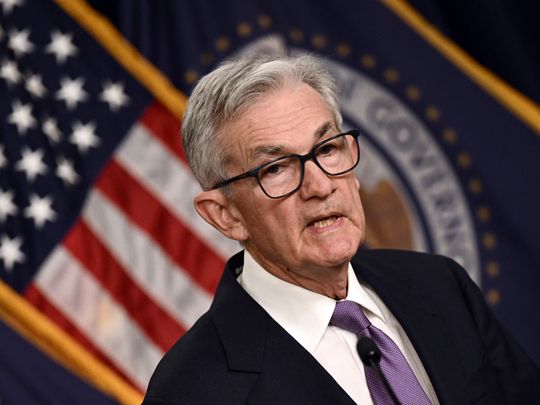
Washington: The appetite of Federal Reserve policymakers for another large interest-rate cut in November may come into better focus in the coming week as Jerome Powell addresses economists and the government issues new employment numbers.
The Fed chair will discuss the US economic outlook at a National Association for Business Economics conference on Monday. At the end of the week, the September jobs report is expected to show a healthy, yet moderating, labor market.
Payrolls in the world's largest economy are seen rising 146,000, based on the median estimate in a Bloomberg survey of economists. That's similar to the August increase and would leave three-month average job growth near its weakest since mid-2019.
The jobless rate probably held at 4.2 per cent, while average hourly earnings are projected to have risen 3.8 per cent from a year earlier.
Recent labor unrest suggests Friday's jobs report may be the last clean reading of the US employment market before Fed policymakers meet in early November. Boeing Co. factory workers walked off the job in mid-September, and dockworkers on the Atlantic and Gulf coasts are threatening to strike from Oct. 1.
In addition to the heavyweight monthly payrolls report, job openings data on Tuesday are expected to show August vacancies held close to the lowest level since the start of 2021. Economists will also focus on the quit rate and on dismissals to gauge the extent of cooling in labor demand.
What economics says:
"We expect a robust headline print for September nonfarm payrolls, which could even revive talk of "no landing" for the US economy. But we think the headline figure will overstate labor-market strength, partly because of overstatements related to the BLS's 'birth-death' model, and partly due to temporary seasonal effects."
"-Anna Wong, Stuart Paul, Eliza Winger, Estelle Ou and Chris G. Collins, economists. For full analysis, click here
Industry surveys will also help shed light on the private-sector hiring. The Institute for Supply Management releases its September manufacturing survey on Tuesday and services index two days later "- both of which include measures of employment.
In Canada, home sales data for several of the nation's largest cities "- Toronto, Calgary and Vancouver "- will offer a look at how the real estate market is faring after a series of rate cuts from the central bank.
Elsewhere, data predicted to show slowing global inflation "- from the euro zone to Turkey to South Korea "- as well as business surveys in China are among the highlights.
Asia
China kicks things off on Monday with a slew of purchasing manager indexes, a week after authorities unleashed an unusually broad set of stimulus steps that sent stock prices soaring.
The official manufacturing PMI may tick higher while staying contractionary, and the Caixin gauges are seen holding steady just above the boom-or-bust iine.
Manufacturing PMI figures are due a day later from Indonesia, Malaysia, Thailand, Taiwan, Vietnam and the Philippines.
In Japan, Shigeru Ishiba is expected to be named prime minister in a parliamentary vote on Tuesday.
The Bank of Japan's Tankan survey will probably show business sentiment at large firms remained optimistic in the third quarter while small manufacturers stayed slightly pessimistic. Companies are seen revising their capital spending plans a bit higher.
South Korea's inflation is forecast to have cooled in September, giving the central bank an added incentive to consider pivoting to a rate cut in October, while price growth in Pakistan may have eased to the slowest pace since early 2021.
Trade data are due from Australia, Sri Lanka and South Korea, and Vietnam releases third-quarter gross domestic product and September inflation next weekend.
Europe, Middle East, Africa
Euro-zone data will take center stage. With inflation in France and Spain now below the European Central Bank's 2 per cent target, reports from German and Italy on Monday, followed by the overall result for the region on Tuesday, will be closely watched.
With traders now pricing in a rate cut at the October ECB meeting, and economists starting to shift forecasts to predict the same, the data will be crucial evidence for policymakers who'd earlier leaned toward December for their next move.
Industrial production numbers from France and Spain on Friday, meanwhile, will provide a glimpse of how weak manufacturing was during the quarter about to end.
The week features a multitude of ECB appearances, starting Monday with President Christine Lagarde's testimony to the European Parliament and followed the next day by a conference in Frankfurt hosted by the central bank.
Monday will be the final day in office of Swiss National Bank President Thomas Jordan, who just oversaw a rate cut and the signal of more to come. His deputy, Martin Schlegel, will succeed him, and Thursday will see the release of the first inflation data under his watch.
In Sweden, minutes from the Riksbank's Sept. 24 meeting on Tuesday will provide more insight into why policymakers there decided to cut rates last week and open the door to a faster pace of easing in the months ahead.
The UK has a relatively quiet week ahead, with appearances by Bank of England chief economist Huw Pill and policymaker Megan Greene among the highlights.
Turkish inflation due on Thursday probably slowed to 48 per cent in September. That would be below the central bank's key rate "- currently at 50 per cent "- for the first time in years. While a sign of progress, officials still have work to do to reach a target of sub-40 per cent inflation by the end of the year.
A number of monetary decisions are scheduled around the wider region:
Latin America
Colombian policymakers are all but certain to deliver a seventh consecutive reduction in rates on Monday, matching its longest easing cycle in over two decades.
Economists anticipate a fifth straight half-point cut, to 10.25 per cent, and say the easing cycle still has room to run with inflation prints and expectations in decline. The bank posts the meeting's minutes three days later.
Most analysts expect that Chile's data dump "- seven separate indicators including industrial production, retail sales, copper output and GDP-proxy data "- should show that the economy is gaining momentum heading toward year-end.
Consumer prices in Peru's capital city of Lima likely held just above the 2 per cent mid-point of the central bank's inflation target range in September.
Peru's central bank chief Julio Velarde has said the year-end reading should be between 2 per cent and 2.2 per cent, and that the key rate can fall some 100 basis points below the Fed's benchmark.
In Brazil, three purchasing manager indexes and industrial production data can be expected to show that Latin America's biggest economy is running hot and above its potential growth rate.
Primary and nominal budget balance reports arrive as the nation's public finances have once again become a hot button issue.












